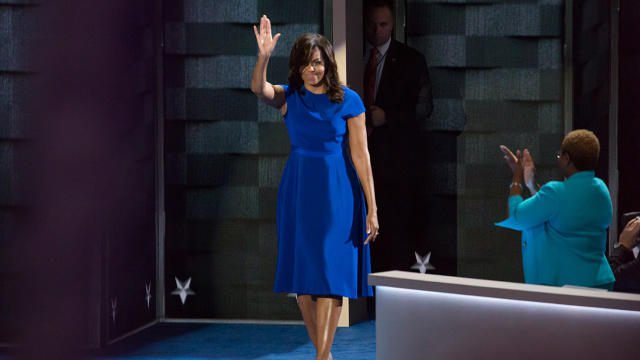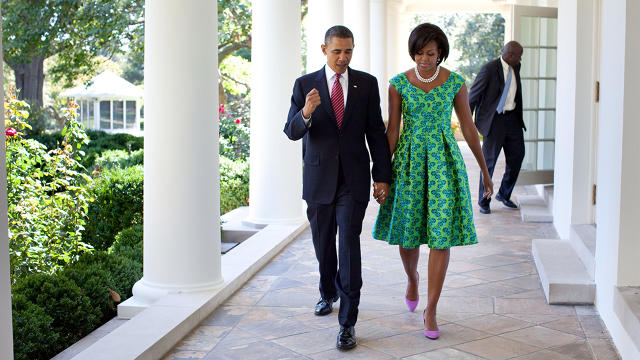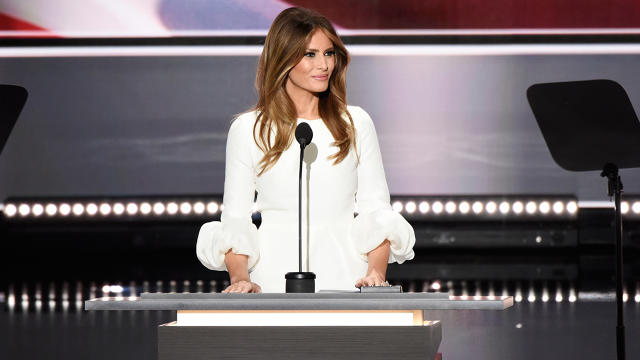The Financial Impact Of First Lady Fashion: Can We Expect A “Melania Effect”?
Melania Trump caused a stir at the Republican National Convention last month, mostly because her speech plagiarized parts from Michelle Obama’s 2008 Democratic National Convention address. But she also made headlines for a less controversial reason: her outfit.
The former model opted for a pristine white crepe dress with dramatic billowy sleeves. Designed by Serbian designer Roksanda Ilincic, it was eye-catching, playful, and most importantly, appropriate for the national political stage. It received rave reviews; critics said it was “absolutely stunning,” that it “dazzled delegates,” and that Melania was “the better-dressed Trump.”
“This current election is Washington, D.C. politics, Hollywood drama, and New York society rolled into one,” says fashion expert and author Melissa Magsaysay. “These days, when the world cares about what a public person wears to the grocery store, you bet they’re going to take notice of what a major political figure involved in this election in any capacity is wearing—what it means, what it looks like, and whether they like it or not.”
A well-received dress goes beyond cementing an individual as a style icon: It means sales. The Slovenian-born wife of Donald Trump bought the $2,190 dress on fashion luxury e-tailer Net-a-Porter, which sold out of the item within 24 hours of her appearance. You can now only buy the dress on resale sites, including eBay, for as much as $5,000.

Mrs. Trump’s spokesman confirmed to Fast Company that she does not work with a stylist; she picks out all her own outfits, which adds even more weight to her choices. London-based designer Roksanda Ilincic is well respected (you’ve likely spotted one of her dresses on Duchess Kate), but following the RNC, her brand recognition skyrocketed: Her name was published in outlets ranging from beauty magazines to hard news sites. Regardless of their own political leanings, many consumers are interested in learning—and copying—Mrs. Trump’s luxury style. (The label Roksanda confirmed Trump wore their brand, but did not offer further statements to Fast Company.)
“Melania Trump is undoubtedly beautiful, glamorous, and poised to perfection, so she seems to appeal to people in the way a traditional model or actress might,” Magsaysay says. “She exudes the ideal Park Avenue lifestyle, which can certainly be appealing.”
Of her own taste in fashion, Trump told Harper’s Bazaar that she’s drawn to how former first lady Jacqueline Kennedy dressed. “She had a very beautiful, elegant, simple but feminine style,” she said in a January interview.
You likely won’t spot H&M or the Gap in Trump’s wardrobe. She’s drawn to high-end labels such as Dolce and Gabbana, Valentino, and Dior, which designed her $100,000 custom wedding gown. She favors sophisticated monochromatic ensembles in bright, bold colors or cool pastels that would make the average woman fear holding a cup of coffee.
“Melania has yet to put her political style stamp on the podium, that is still in the midst of being created,” says Lauren A. Rothman, stylist and author of Style Bible: What to Wear To Work. Rothman, who has dressed politicians for over 14 years, notes that light colors are not meant for all-day wear. Mrs. Trump is dressing for appearances rather than long political campaign days, which involving shaking thousands of hands or holding babies—stuff that can lead to stains. As Mrs. Trump’s schedule gets increasingly hectic with longer days on the campaign trail and a higher likelihood of encounters with stains, she may well shift to a darker palette, Rothman says. “Lighter colors feel like a wardrobe change is coming, and she can afford that.”

The Obama Effect
What can Trump’s style choices—and what she conveys through them—mean to the fashion industry, should her husband win the election? Looking back at Michelle Obama, a lot.
“At the height of her popularity, Michelle Obama created about $10 billion a year in value for different fashion companies—one day at a time,” says David Yermack, a professor of finance at the Stern School of Business at New York University. “Within a year, she would made hundreds of public appearances. If you looked at the total created, it was much, much more than we would attribute to any other celebrity.”
Yermack studied the financial impact of Michelle Obama’s fashion in his research study titled “The Michelle Markup: The First Lady’s Impact on Stock Prices of Fashion Companies.” After compiling the data on all her appearances, he concluded, “There’s no one that remotely compares to Michelle Obama.”
In fact, you can almost put a monetary worth on each time Mrs. Obama wore a label. Big events such as state dinners or the State of the Union can cause a spike of sales or push company stock prices to rise half a billion to a billion dollars. Meanwhile, routine events—school speeches, charity events, talk show appearances—are worth $10 million to $20 million dollars on average.
For example, after the First Lady traveled to Copenhagen on behalf of Chicago’s bid to host the 2016 Summer Olympics, the valuation of five brands she wore made roughly $748 million over the next few days. Not to mention, Internet searches for the designers rose by roughly 21%. Some designer websites reported immediate traffic increases by 60%.
“What was different about [Michelle Obama] was that her fashion choices were basically spontaneous and not sponsored by a company, so consumers seemed to put much higher weight on them,” Yermack says.
Obama’s wardrobe launched the careers of over a dozen designers, including Jason Wu, Maria Pinto, and Narciso Rodriguez. It changed the fashion landscape by introducing a novel marketing strategy that could catapult an indie designer into household-name status.
If the fashion industry primarily depended on Hollywood celebrities as a secret weapon marketing tool, Obama changed that. “There’s now another player in the game that can make your brand,” says Rothman. “[Michelle] opened the door for politics. She may wear your dress, and that can change your life because it changes your sales and your exposure.”
Several factors contribute to Michelle Obama’s explosive success. First, she resonated with the average American woman. Her decision to mix high-end designers with more approachable mass-retail brands, such as Talbots or J.Crew, motivated the public to believe that they too could aspire to an elegant wardrobe worthy of the White House.
During an October 2008 interview on The Tonight Show with Jay Leno, the talk show host questioned Obama on her outfit’s price tag—a nod to then-Republican vice president nominee Sarah Palin’s reported $150,000 shopping spree. Obama responded with an unexpected shopping tip: “Actually, this is a J.Crew ensemble,” she said with a laugh. “Ladies, we know J.Crew. You can get some good stuff online!” In that moment, she was casual, friendly, and relatable—and America was smitten. J.Crew Group Inc.’s stock price jumped by 8% the next day and 25% by the end of the week. A year later, the company’s shares had spiked 175%, a gain of about $1.8 billion after numerous media reports linked J.Crew to the First Lady, according to Yermack’s report.

Obama also broke barriers in terms of what a woman in an executive position looks like. She opted for dresses, not blazers; preferred color and vibrant prints to nondescript hues; and wore kitten heels instead of high heels.
“She wore flattering clothing, but not items you would necessarily expect,” Rothman says. “She portrayed confidence with a real woman’s body.” Low-heeled Jimmy Choos made sense for Michelle Obama’s active lifestyle as a mom to two young daughters, Malia and Sasha, who were just 10 and 7 when their dad took over the Oval Office. “So now the everyday woman feels better about wearing a lower heel,” Rothman says.
Another factor that differentiates Obama from former first ladies was that she entered the White House during the age of fast fashion. Mass retailers like H&M and Topshop quickly produced styles made popular by Obama. “The fashion landscape changed in the last eight years,” Rothman says. “Now, you don’t have to have a lot of money to be well dressed.”

A Melania Effect?
But will Mrs. Trump, who once posed with a gilded baby carriage, connect as easily with the American public?
In some ways, it’s not fair to compare her to Michelle. The current First Lady set off the perfect storm of fashion crazes and wasn’t faced with the same divisive politics plaguing the country today.
“Her influence has been extremely large, but in many ways, she’s likely a unique case, and I wouldn’t expect anywhere near the same thing from any other person,” Yermack says. “Michelle was popular with Democrats, Republicans, and at times, even more popular than her husband. She was often very much able to transcend the politics and connect with the greater public.”
Magsaysay believes Melania Trump could become a major fashion fixture, but not for the same reasons Americans gravitated toward Obama. “Mrs. Trump has an icy, intimidating appeal, when Mrs. Obama’s is warm and embracing,” says Magsaysay, who sees Trump continuing to champion high-end designers and luxury items. “As the world gets to know Mrs. Trump better, and if her personality and work is appealing to them, then her fashion choices will have even more of an impact… I hope she continues to take a bit of a risk, because she knows how to wear clothes and looks good in styles from classic to cutting edge.”
Though even at such an early political stage, Trump is likely calculating what she intends to convey through her ensembles. As Rothman sees it, no outfit meant for a public stage is chosen willy-nilly. It’s selected with great care for a particular meaning, even when it appears to have none.
“Wardrobe choices should be strategic on the political stage,” Rothman says. “You move people through what you wear, because what you wear helps communicate your message.”
And therein lies the opportunity for Trump, who has yet to fully transmit her message. Perhaps we will soon see a more casual and approachable side, which she undoubtedly has. In a 2012 interview with Refinery29, Trump talked about her day-to-day wear: jeans, T-shirts, and pieces from her own affordable QVC jewelry line.
When asked what she prefers when hanging out with her son, Barron, she said, “Sometimes I wear flats because I’m running around. I love to wear something comfortable like a T-shirt … You need to be comfortable.” And on her jewelry philosophy, she explained, “To keep your look elegant and chic, you have to mix pieces that are not so flashy with pieces that are for special occasions.”
That sounds like a mix of high and low, which the American public has grown to love and the fashion industry depends on. As Rothman says, Trump could be influential if she integrates mass retail pieces into her campaign wear: “If we can see Melania Trump start to wear a little more Ivanka Trump, I think that would help.”
Fast Company , Read Full Story
(42)













